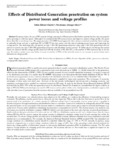| dc.contributor.author | Charles, Julius Kilonzi | |
| dc.contributor.author | Odero, Nicodemus Abungu | |
| dc.date.accessioned | 2018-12-03T12:41:10Z | |
| dc.date.available | 2018-12-03T12:41:10Z | |
| dc.date.issued | 2013 | |
| dc.identifier.issn | 2250-3153 | |
| dc.identifier.uri | http://hdl.handle.net/123456780/2085 | |
| dc.description.abstract | In present times, the use of DG systems in large amounts in different power distribution systems has become very popular
and is growing on with fast speed. Although it is considered that DG reduces losses and improves system voltage profile, this paper
shows that this is not always true. The paper presents a GA-IPSO based approach which utilizes combined sensitivity factor analogy
to optimally locate and size a multi-type DG in IEEE 57-bus test system with the aim of reducing power losses and improving the
voltage profile. The multi-type DG can operate as; type 1 DG (DG generating real power only), type 2 DG (DG generating both real
and active power) and type 3 DG (DG generating real power and absorbing reactive power). It further shows that though the system
losses are reduced and the voltage profile improved with the location of the first DG, as the number of DGs increases this is not the
case. It reaches a point where any further increase in number of DGs in the network results to an increase in power losses and a
distortion in voltage profile. | en_US |
| dc.language.iso | en_US | en_US |
| dc.publisher | International Journal of Scientific and Research Publication | en_US |
| dc.subject | Distributed Generation (DG) | en_US |
| dc.subject | Particle Swarm Optimization (PSO) | en_US |
| dc.subject | Genetic Algorithm (GA) | en_US |
| dc.subject | System loss reduction | en_US |
| dc.subject | Voltage profile improvement | en_US |
| dc.title | Effects of Distributed Generation penetration on system power losses and voltage profiles | en_US |
| dc.type | Article | en_US |

